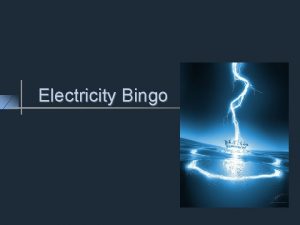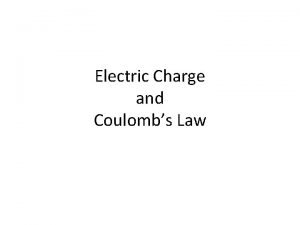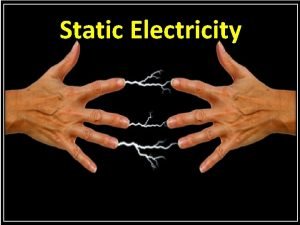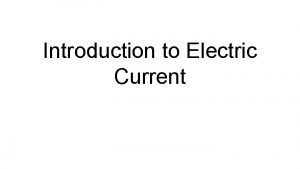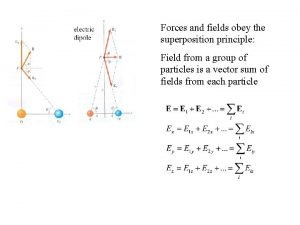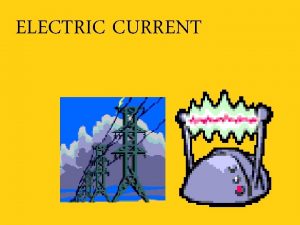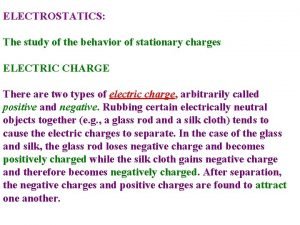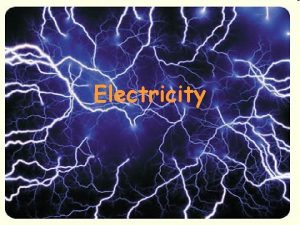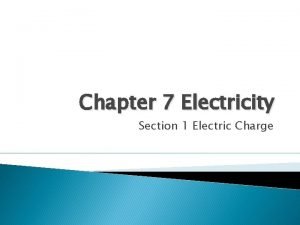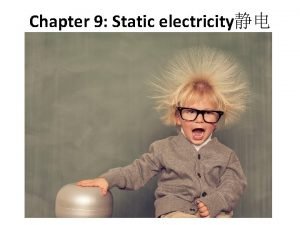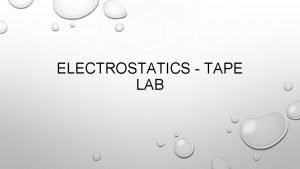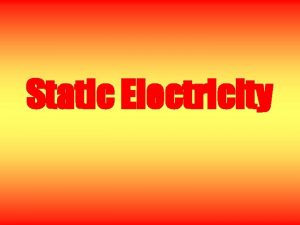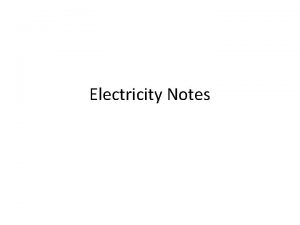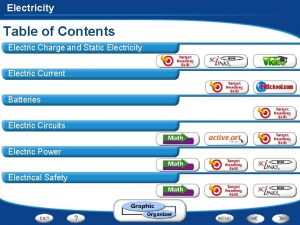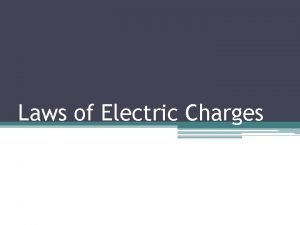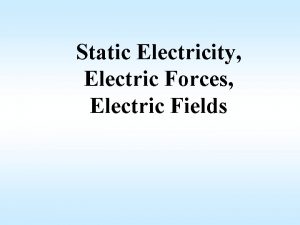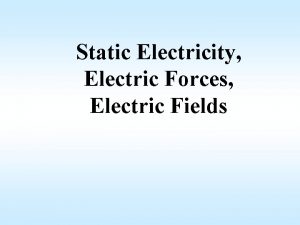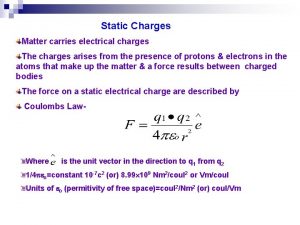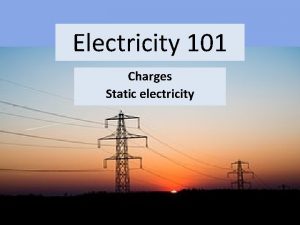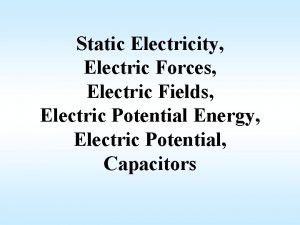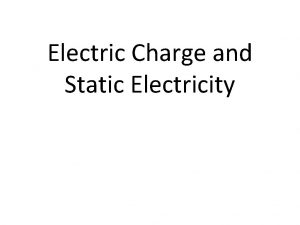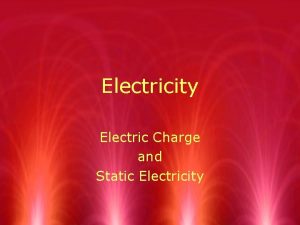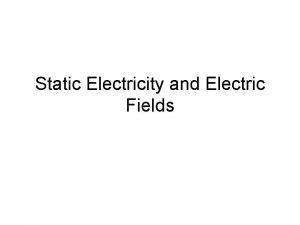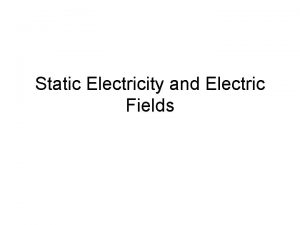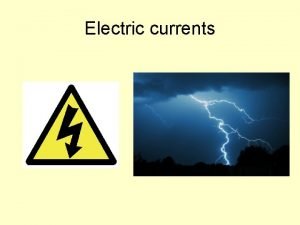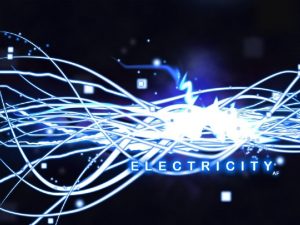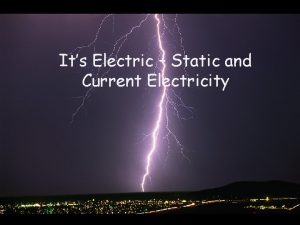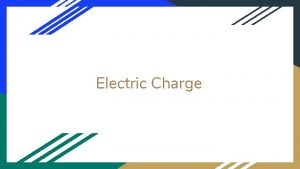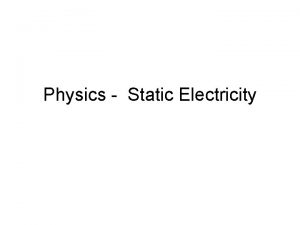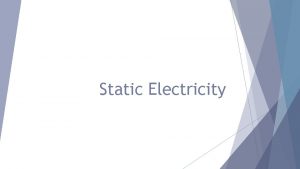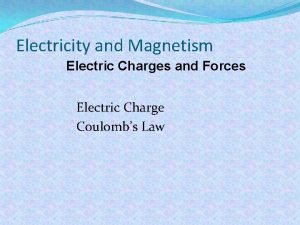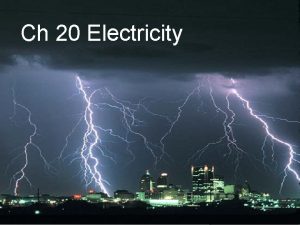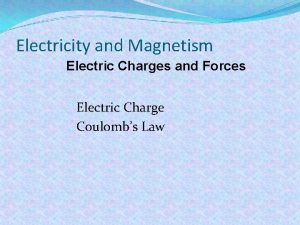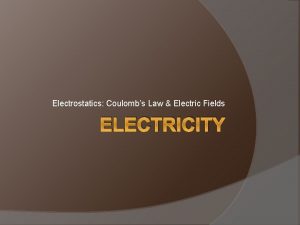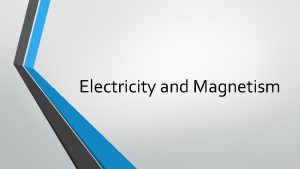Static Electricity Static electricity occurs when electric charges
































- Slides: 32

Static Electricity • Static electricity occurs when electric charges build up on the surface of a material • Static shock occurs when uncontrolled electrons pass form one body to another in sudden, momentary movements How is the charge transferred when a child goes down a slide and gets static-y hair?

Static Electricity • electric charges build up on the SURFACE of the rod and wool

Static Electricity • The electric charges redistribute on the surface of the sphere • The negatively charged rod repels the electrons and attracts the protons

Static vs Current • So, static electricity is just that – static – it doesn’t continuously move. . . • However, current electricity does o. Current electricity is the continuous flow of electric charge • Electric current is measured in amps or amperes (A)

Conductors and Insulators Why is metal wire usually coated with plastic or rubber? • Because metal wire is a good conductor • The plastic and rubber are good insulators • The coating around the wire helps to isolate the current and keep it where it’s needed

Conductors and Insulators • An electrical conductor is a material through which charge can flow easily • An electrical insulator is a material through which charge cannot flow easily

Conductors and Insulators • Good electrical conductors are copper and silver • Good electrical insulators are glass, plastic, and rubber

Resistance • As electrons move through a conducting wire, they collide with electrons and ions • These collisions convert some kinetic energy into thermal energy

Resistance Because less energy is available to move electrons through the wire, the current is reduced. more collisions = more resistance = more energy lost

Resistance is the opposition to the flow of charges in a material. • SI unit of resistance is the ohm (Ω)

Think Is it easier to drink a milkshake with a thick straw or a thin straw?

Milkshake Analogy When drinking a milkshake, you would rather use a thicker straw. In the same way, resistance is lowered if you make a wire thicker because more electrons flow through it.

Resistance A material’s thickness, length, and temperature affect is resistance • resistance is greater in a longer wire because the charges travel farther • As temperature increases, a metal’s resistance increases because electrons collide more often

Voltage Because there is resistance in the wires and the bulb, charges do not flow on their own without a source of energy, or voltage.

Voltage In order for a charge to flow in a conducting wire, the wire must be connected in a complete loop that includes a source of electrical energy. battery solar cell generator

Battery A battery is a device that converts chemical energy to electrical energy.

Ohm’s Law German scientist Georg Ohm determined how resistance and current affect voltage, the difference in electrical potential energy between any two points.

Ohm’s Law tells us the relationship between voltage (V), current (I), and resistance (R). V=Ix. R V = voltage measured in volts I = current measured in amperes (amps) R = resistance measured in ohms (Ω)

The Power Equation The relationship between current, voltage, and power is represented by the power equation: P = VI V = voltage measured in volts I = current measured in amperes (amps) P = power (W)

Guided Practice 1 What resistance would produce a current of 200 amps with a potential difference of 1, 000 volts? • Given: • Looking for • Formula • Answer

Guided Practice 2 What is the current produced with a 9 -volt battery through a resistance of 100 ohms? • Given: • Looking for • Formula • Answer

Guided Practice 3 What is the current produced by a potential difference of 240 volts through a resistance of 0. 2 ohms? • Given: • Looking for • Formula • Answer

Guided Practice 4 What resistance would produce a current of 120 amps from a 6 -volt battery? • Given: • Looking for • Formula • Answer STOP

Electric Circuit • An electric circuit is a complete path through charge can flow which _______ • An electrician uses circuit diagrams to keep track of how different parts of a circuit are connected Circuit diagrams use symbols to represent parts of a circuit, including a source of electrical energy and devices that are run by the electrical energy

Electric Circuit • An electric circuit is a complete path through charge can flow which _______ • Switches show places where the circuit can be opened or _______ closed ____ • If a switch is open, the circuit is not a stops – this complete loop, and the current ______ called an open circuit • When the switch is closed, the circuit is can flow – this is complete and charge _____ called a closed circuit

Electric Circuit can • In a closed circuit, charge ______ flow cannot flow • In an open circuit, charge ____ Closed circuit diagram Open circuit diagram l d u a b t lo h lig sw l o v g a t itc b h a b y r e t t sw i tch

Series Circuits • In a series circuit, charge has only one path which it can flow o If one light bulb on the strand of lights blows, they all go out

Series Circuits The bulbs in a circuit are a source of resistance. • Adding bulbs to a series circuit increases the resistance.

Parallel Circuits • A parallel circuit is an electric circuit with two or more paths through which charges can flow • If one light bulb on the strand goes out, the rest will keep shining

Circuit: Review • In a series circuit, charge has only _____ one path which it can flow; if one light bulb goes out, they ALL go out • A parallel circuit is an electric circuit with ______ 2 or morepaths through which charges can flow § If one goes out, the rest KEEP working

Identify #1 serie s #4 serie s #6 parallel #2 parallel #3 parallel #5 serie s Label each as either series or

Schematic Circuit Symbols • Some circuit symbols used in schematic diagrams are shown below Switch Connectin Singl (open) (closed) g wire Resistor e cell Battery Light bulb
 Electric charges and electric forces lesson outline
Electric charges and electric forces lesson outline Static electricity and current electricity
Static electricity and current electricity How are static electricity and current electricity alike
How are static electricity and current electricity alike Static electricity and current electricity
Static electricity and current electricity Like charges blank and opposite charges blank
Like charges blank and opposite charges blank R in coulomb's law
R in coulomb's law The figure shows three electric charges labeled
The figure shows three electric charges labeled The study of stationary electric charges is
The study of stationary electric charges is The buildup of electric charges on an object
The buildup of electric charges on an object What is the continuous flow of electric charge?
What is the continuous flow of electric charge? Electron charge
Electron charge Electric field due to system of charges
Electric field due to system of charges Electric charges
Electric charges Net movement of electric charges in a single direction
Net movement of electric charges in a single direction What is the study of stationary electric charges
What is the study of stationary electric charges Chapter 6 electricity section 1 electric charge answers
Chapter 6 electricity section 1 electric charge answers Electricity section 1 electric charge
Electricity section 1 electric charge Electricity section 1 electric charge
Electricity section 1 electric charge Electric field from electric potential
Electric field from electric potential Coloumb units
Coloumb units Electric potential energy work formula
Electric potential energy work formula A suitable electric pump in an electric circuit is a
A suitable electric pump in an electric circuit is a Units of a charge
Units of a charge Joules per coloumb
Joules per coloumb Chapter 21 electric charge and electric field
Chapter 21 electric charge and electric field Electric potential energy
Electric potential energy Chapter 21 electric charge and electric field
Chapter 21 electric charge and electric field Static electricity
Static electricity Static electricity tape lab
Static electricity tape lab Static electricity.
Static electricity. What is static electricity
What is static electricity Graphic organizer electric current
Graphic organizer electric current Electrons electricity
Electrons electricity




